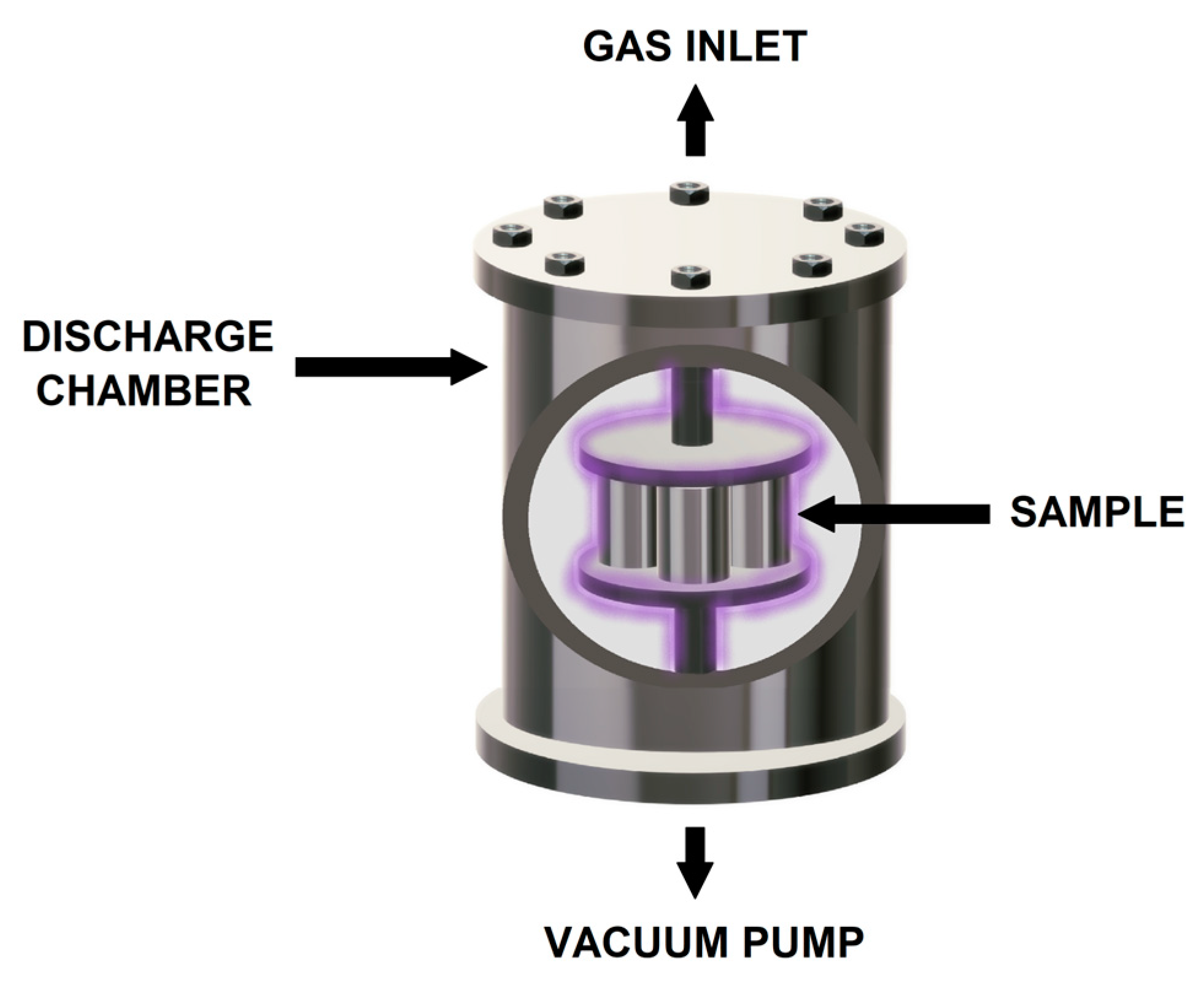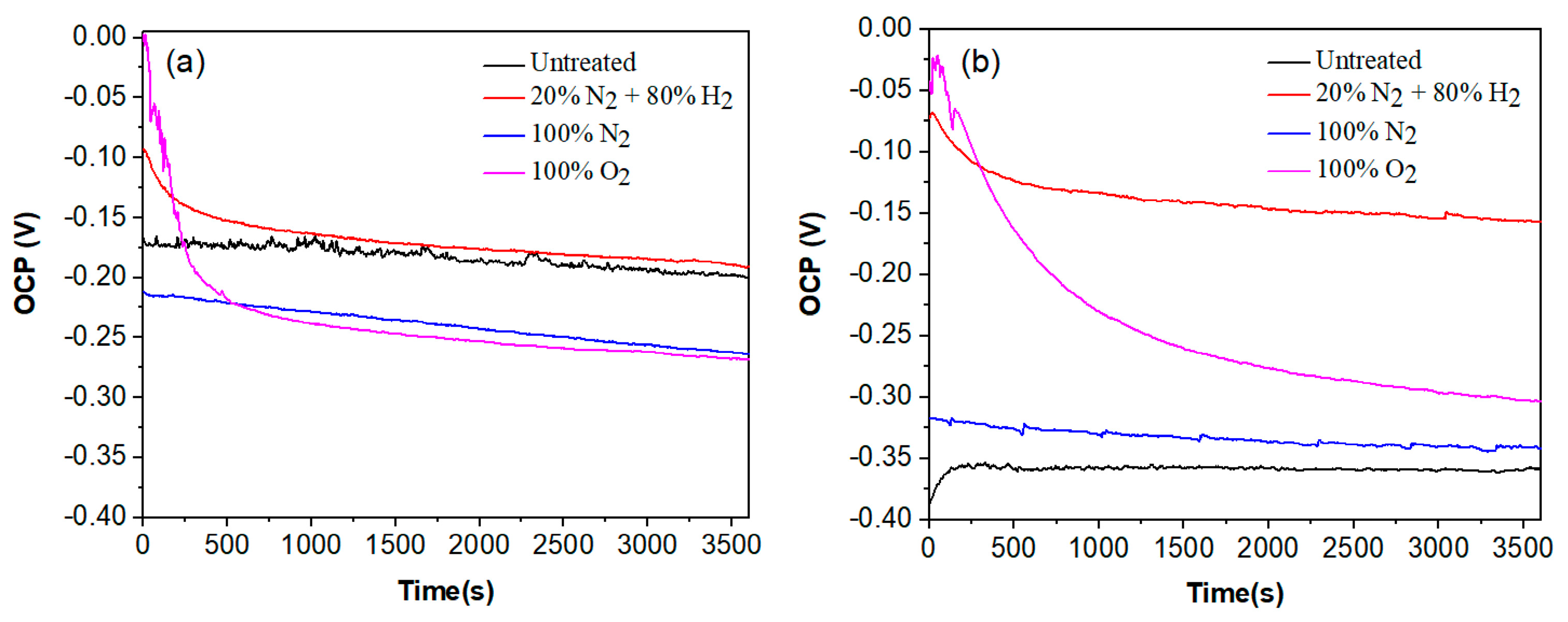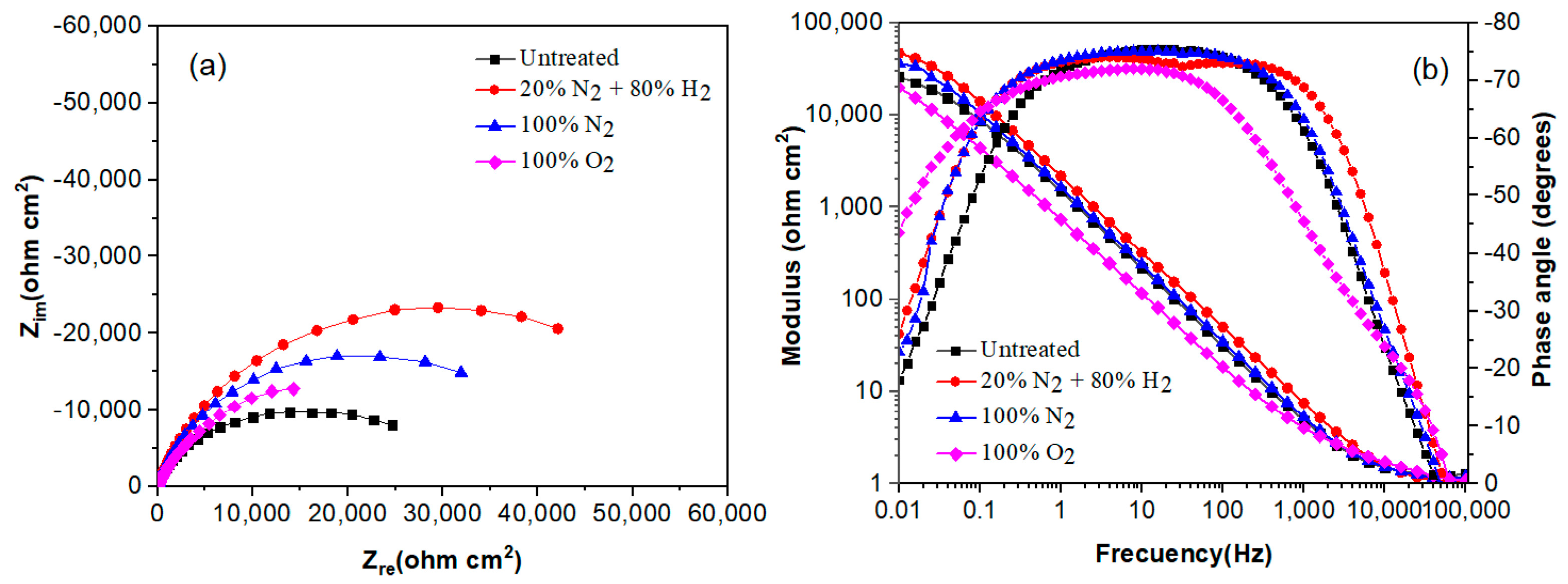Effect of Plasma Nitriding and Oxidation on the Corrosion Resistance of 304 Stainless Steel in LiBr/H2O and CaCl2-LiBr-LiNO3-H2O Mixtures
Abstract
:1. Introduction
2. Experimental
2.1. Testing Material
2.2. Plasma Nitriding and Pre-Oxidation Treatment
2.3. Electrochemical Measurements
2.4. Microstructural Characterization
3. Results
3.1. X-ray Diffraction (XRD) Analysis
3.2. SEM Characterization
3.3. Electrochemical Tests
3.3.1. Open Circuit Potential
3.3.2. Potentiodynamic Polarization Curves
3.3.3. Electrochemical Impedance Spectroscopy (EIS)
3.4. Surface Analysis
4. Conclusions
- By plasma nitriding 304 type stainless steel either in 20% N2 + 80% H2 or pure N2 at a pressure of 2.0 torr and a temperature of 500 °C for 8 h, a nitride layer 5.85 and 3.37 µm thick, respectively, is produced. This layer is composed mainly of γ-Fe and CrN.
- The noblest OCP value in both LiBr/H2O and CaCl2-LiBr-LiNO3/H2O solutions was for steel nitrided in the 20% N2 + 80% H2 atmosphere, whereas the most active value was for both untreated or pre-oxidized steel.
- Polarization curves showed the presence of a passive layer in all cases regardless of the surface steel condition in both solutions. The lowest Ipas was obtained for nitrided steels. In LiBr/H2O, the Epit value was only marginally affected by the plasma treatments, but in CaCl2-LiBr-LiNO3/H2O the noblest values were obtained for nitrided steels. Similarly, the lowest corrosion current density value was obtained for steel nitrided in the 20% N2 + 80% H2 atmosphere.
- EIS results showed that the corrosion process is under charge transfer control regardless of the surface treatment in both LiBr/H2O and CaCl2-LiBr-LiNO3/H2O solutions. The film resistance of the nitride layers was higher than that for untreated or pre-oxidized steel, giving a higher corrosion resistance to the steel.
- The type of corrosion damage that the steel exhibited in both LiBr/H2O and CaCl2-LiBr-LiNO3/H2O solutions was the pitting type of corrosion. However, the highest damage was for either untreated or pre-oxidized steel, whereas the lowest damage was for nitride steels.
Author Contributions
Funding
Data Availability Statement
Acknowledgments
Conflicts of Interest
References
- Bricker, B. Scientific Counterpublics: In Defense of the Environmental Scientist as Public Intellectual. Topoi 2019, 38, 681–692. [Google Scholar] [CrossRef]
- Ali, S.R. Review on ozone depletion and global warming. Int. Multidiscip. Res. J. 2021, 11, 2072–2078. [Google Scholar]
- Montzka, S.A.; Dutton, G.S.; Portmann, R.W.; Chipperfield, M.P.; Davis, S.; Feng, W.; Theodoridi, C. A decline in global CFC-11 emissions during 2018−2019. Nature 2021, 590, 428–432. [Google Scholar] [PubMed]
- Mohammadi, K.; Powell, K. Thermodynamic and economic analysis of different cogeneration and trigeneration systems based on carbon dioxide vapor compression refrigeration systems. Appl. Therm. Eng. 2020, 164, 114503. [Google Scholar] [CrossRef]
- Venkatarathnam, G.; Murthy, S.S. Refrigerants for Vapour Compression Refrigeration Systems. Resonance 2012, 17, 139–162. [Google Scholar] [CrossRef]
- Sleiti, A.K.; Al-Ammari, W.A.; Al-Khawaja, M. Review of innovative approaches of thermo-mechanical refrigeration systems using low grade heat. Int. J. Energy Res. 2020, 44, 9808–9838. [Google Scholar] [CrossRef]
- Chowdhury, S.; Roy, R.; Mandal, B.K. A Review on Energy and Exergy Analysis of Two-Stage Vapour Compression Refrigeration System. Int. J. Air-Cond. Refrig. 2019, 27, 9. [Google Scholar] [CrossRef]
- Luberti, M.; Di Santis, C.; Santori, G. Ammonia/Ethanol Mixture for Adsorption Refrigeration. Energies 2020, 13, 983. [Google Scholar] [CrossRef]
- Vuppaladadiyam, A.K.; Antunes, E.; Vuppaladadiyam, S.S.V.; Baig, Z.T.; Subiantoro, A.; Lei, G.; Leu, S.; Sarmah, A.K.; Duan, H. Progress in the development and use of refrigerants and unintended environmental consequences. Sci. Total Environ. 2022, 823, 153670. [Google Scholar] [CrossRef]
- Zhang, X.; Qiu, Y.; Zhu, W.; Yu, W.; Cao, Y.; Wang, X.; Liang, Y. Corrosion behavior of 316 stainless steel, copper, and brazed joint in lithium bromide solution at different temperatures. Mater. Test. 2022, 64, 67–77. [Google Scholar] [CrossRef]
- Elhamid, S.A.; Meleigy, A.E.; Attia, A.; Warraky, A.E.; Abd-El-Wahab, S. Corrosion Behaviour of Copper– nickel Alloys in LiBr Solutions: A Comparative Study. Egypt. J. Chem. 2020, 63, 907–919. [Google Scholar] [CrossRef]
- Li, N.; Luo, C.; Su, Q. A Working pair of CaCl2–LiBr–LiNO3/H2O and its application in a single-stage solar-driven absorption refrigeration cycle. Int. J. Refrig. 2018, 86, 1–13. [Google Scholar] [CrossRef]
- Li, Y.; Li, N.; Luo, C.; Su, Q. Study on a Quaternary Working Pair of CaCl2-LiNO3-KNO3/H2O for an Absorption Refrigeration Cycle. Entropy 2019, 21, 546. [Google Scholar] [CrossRef] [PubMed]
- Ravindra, K.; Bhardwaj, D.; Sharma, Y.C. A review on Plasma Ion Nitriding (PIN) process. i-manager’s. J. Mater. Sci. 2018, 6, 31. [Google Scholar]
- De Souza Lamim, T.; Salvaro, D.; Oss Giacomelli, R.; Binder, R.; Binder, C.; Klein, A.N.; Biasoli de Mello, J.D. Plasma nitrided compound layers in sintered parts: Microstructures and wear mechanisms. Wear 2021, 477, 203810. [Google Scholar] [CrossRef]
- Jasinski, J.J.; Fraczek, T.; Kurpaska, L.; Lubas, M.; Sitarz, M. Investigation of nitrogen transport in active screen plasma nitriding processes e Uphill diffusion effect. J. Mol. Struct. 2018, 484, 710–715. [Google Scholar] [CrossRef]
- Huang, Z.; Guo, Z.; Liu, L.; Guo, Y.; Chen, J.; Zhang, Z.; Li, J.; Li, Y.; Zhou, Y.; Liang, Y. Structure and corrosion behavior of ultra-thick nitrided layer produced by plasma nitriding of austenitic stainless steel. Surf. Coat. Technol. 2021, 405, 126689. [Google Scholar] [CrossRef]
- Alphonsa, J.; Mukherjee, S.; Raja, V.S. Study of plasma nitriding and nitrocarburizing of AISI 430F stainless steel for high hardness and corrosion resistance. Corros. Eng. Sci. Technol. 2018, 53, 51–58. [Google Scholar] [CrossRef]
- Shen, H.; Wang, L.; Sun, J. Characteristics and properties of Cr-N compound layer produced by plasma nitriding of Cr-electroplated of AISI 304 stainless steel. Surf. Coat. Technol. 2020, 385, 125450. [Google Scholar] [CrossRef]
- Naeem, M.; Iqbal, J.; Zakaullah, M.; Shafiq, M.; Mujahid, Z.I.; Díaz-Guillén, J.C.; Lopez-Badillo, C.M.; Sousa, R.R.M.; Khana, M.A. Enhanced wear and corrosion resistance of AISI-304 steel by duplex cathodic cage plasma treatment. Surf. Coat. Technol. 2019, 375, 34–45. [Google Scholar] [CrossRef]
- Núñez, Y.; Mafra, M.; Morales, R.E.; Borges, P.C.; Pintaude, G. The effect of plasma nitriding on the synergism between wear and corrosion of SAF 2205 duplex stainless steel. Ind. Lubr. Tribol. 2020, 72, 1117–1122. [Google Scholar] [CrossRef]
- Ma, L.; Pascalidou, E.M.; Wiame, F.; Zanna, S.; Maurice, V.; Marcus, P. Passivation mechanisms and pre-oxidation effects on model surfaces of FeCrNi austenitic stainless steel. Corros. Sci. 2020, 167, 108483. [Google Scholar] [CrossRef]
- Huang, X.; Li, X.; Zhan, Z.; Xiao, K.; Fang, X.; Li, Z. Effect of Long-Term Pre-oxidation on the Corrosion Rate of 316L Stainless Steel in a High-Temperature Water Environment. J. Mater. Eng. Perform. 2022, 31, 7935–7944. [Google Scholar] [CrossRef]
- Naofumi, O.; Koyo, M.; Mitsuhiro, H.; Kenji, K. Investigation of admixed gas effect on plasma nitriding of AISI316L austenitic stainless steel. Vacuum 2021, 193, 110545. [Google Scholar]
- De Souza Lamim, T.; Bernardelli, E.; Bendo, T.; Melo, C.H.; Binder, C.; Klein, A. Duplex surface treatment of sintered iron by plasma nitriding and plasma carburizing at low temperature. Surf. Coat. Technol. 2019, 375, 911–919. [Google Scholar] [CrossRef]
- Moskalioviene, T.; Galdikas, A. Mechanisms of the Hydrogen Influence on the Diffusivity of Nitrogen During Plasma Nitriding Austenitic Stainless Steel. Metall. Mater. Trans. A 2019, 50, 1021–1032. [Google Scholar] [CrossRef]
- Dalke, A.; Burlacov, I.; Hamann, S.; Puth, A.; Böcker, J.; Spies, H.J.; Röpcke, J.; Biermann, H. Solid carbon active screen plasma nitrocarburizing of AISI 316L stainless steel: Influence of N2-H2 gas composition on structure and properties of expanded austenite. Surf. Coat. Technol. 2019, 357, 1060–1068. [Google Scholar] [CrossRef]
- Vasyliev, G.; Pylypenko, I.; Kuzmenko, O.; Gerasymenko, Y. Fouling influence on pitting corrosion of stainless steel heat exchanging surface. Therm. Sci. Eng. Prog. 2022, 30, 101278. [Google Scholar] [CrossRef]
- Messinese, E.; Casanova, L.; Paterlini, L.; Capelli, F.; Bolzoni, F.M.; Ormellese, M.; Brenna, A. A Comprehensive Investigation on the Effects of Surface Finishing on the Resistance of Stainless Steel to Localized Corrosion. Metals 2022, 12, 1751. [Google Scholar] [CrossRef]
- Gokcekaya, O.; Ergun, C.; Gulmez, T.; Nakano, T.; Yilmaz, S. Structural Characterization of Ion Nitrided 316L Austenitic Stainless Steel: Influence of Treatment Temperature and Time. Metals 2022, 12, 306. [Google Scholar]
- Dib, J.; Gómez, B.; Strubbia, R.; Ares, A.; Méndez, C.; Fuster, V.; Hereñu, S. Characterization of Plasma Nitrided Duplex Stainless Steel: Influence of Prior Shot Peening and Nitriding Atmosphere. J. Mater. Eng. Perform. 2023, 32, 406–414. [Google Scholar] [CrossRef]
- Frączek, T.; Prusak, R.; Ogórek, M.; Skuza, Z. Nitriding of 316L Steel in a Glow Discharge Plasma. Materials 2022, 15, 3081. [Google Scholar] [CrossRef] [PubMed]
- Lynch, B.; Wang, Z.; Ma, L.; Paschalidou, E.M.; Wiame, F.; Maurice, V.; Marcus, P. Passivation-Induced Cr and Mo Enrichments of 316L Stainless Steel Surfaces and Effects of Controlled Pre-Oxidation. J. Electrochem. Soc. 2020, 167, 141509. [Google Scholar] [CrossRef]
- Mroczkowska, K.; Dzienny, P.; Budnicki, A.; Antonczak, A. Corrosion Resistance of AISI 304 Stainless Steel Modified Both Femto- and Nanosecond Lasers. Coatings 2021, 11, 592. [Google Scholar] [CrossRef]
- Ruiz, A.; Hernández, H.; Hernández, J.; Orozco-Cruz, R.; Ruiz-Reynoso, A.; González, C.; Miranda-Hernández, J. Electrochemical Impedance Spectroscopy (EIS): A Review Study of Basic Aspects of the Corrosion Mechanism Applied to Steels. Electrochem. Impedance Spectrosc. 2020, 94470. [Google Scholar] [CrossRef]











| Fe | C | Mn | P | S | Si | Cr | Ni |
|---|---|---|---|---|---|---|---|
| 71.00 | 0.08 | 2.00 | 0.04 | 0.03 | 0.75 | 18.10 | 8.00 |
| Element | Weight % | Atomic % | Weight % | Atomic % | Weight % | Atomic % | Weight % | Atomic % |
|---|---|---|---|---|---|---|---|---|
| Untreated | Nitrided in 20% N2 + 80% H2 | Nitrided in 100% N2 | Pre-Oxidized in 100% O2 | |||||
| Fe K | 64.16 | 57.86 | 48.72 | 27.91 | 41.10 | 20.05 | 51.54 | 32.31 |
| Cr K | 20.18 | 19.54 | 16.00 | 9.84 | 13.18 | 6.91 | 16.45 | 11.08 |
| N K | - | - | 13.84 | 31.62 | 15.54 | 30.22 | - | - |
| O K | 3.45 | 10.85 | 12.54 | 25.07 | 22.84 | 38.89 | 23.00 | 50.33 |
| Si K | 1.07 | 1.91 | 1.01 | 1.15 | 0.87 | 0.85 | 1.22 | 1.52 |
| Mn K | 4.50 | 4.13 | 3.01 | 1.75 | 2.70 | 1.34 | 51.54 | 32.31 |
| Ni K | 6.65 | 5.70 | 4.88 | 2.66 | 3.76 | 1.75 | 4.78 | 2.85 |
| Solution | Gas Concentration | Ecorr (V) | Icorr (A/cm2) | Epit (V) | Ipas |
|---|---|---|---|---|---|
| LiBr-H2O | blank | −0.16 | 2.20 × 10−6 | 0.12 | 2.82 × 10−6 |
| 20% N2–80% H2 | −0.15 | 6.02 × 10−7 | 0.05 | 1.37 × 10−6 | |
| 100% N2 | −0.22 | 1.09 × 10−6 | 0.08 | 1.09 × 10−6 | |
| 100% O2 | −0.30 | 2.27 × 10−6 | 0.01 | 1.41 × 10−6 | |
| CaCl2-LiBr-LiNO3-H2O | blank | −0.50 | 2.35 × 10−6 | −0.07 | 6.43 × 10−6 |
| 20% N2–80% H2 | −0.20 | 4.12 × 10−7 | 0.10 | 8.24 × 10−7 | |
| 100% N2 | −0.17 | 1.06 × 10−6 | 0.14 | 3.53 × 10−6 | |
| 100% O2 | −0.09 | 3.52 × 10−7 | 0.006 | 2.13 × 10−6 |
| Gas Atmosphere | Rs (ohm cm2) | CPEox (snS) | nox | Rox (ohm cm2) | CPEdl (snS) | ndl | Rdl (ohm cm2) | Rp (ohm cm2) |
|---|---|---|---|---|---|---|---|---|
| None | 1.2 | 2.4 × 10−4 | 0.8 | 21,791 | 2.6 × 10−4 | 0.8 | 6321 | 28,113 |
| 20% N2 + 80% H2 | 1.0 | 1.0 × 10−4 | 0.9 | 53,782 | 2.1 × 10−3 | 0.9 | 499 | 54,282 |
| 100% N2 | 1.1 | 2.2 × 10−4 | 0.9 | 30,782 | 2.1 × 10−4 | 0.9 | 6499 | 37,282 |
| 100% O2 | 1.3 | 8.5 × 10−4 | 0.7 | 15,782 | 4.3 × 10−4 | 0.7 | 6499 | 22,282 |
| Gas Atmosphere | Rs (ohm cm2) | CPEox (snS) | nox | Rox (ohm cm2) | CPEdl (snS) | ndl | Rdl (ohm cm2) | Rp (ohm cm2) |
|---|---|---|---|---|---|---|---|---|
| None | 1.48 | 4.3 × 10−4 | 0.7 | 20,181 | 4.1 × 10−4 | 0.7 | 3181 | 23,363 |
| 20% N2 + 80% H2 | 1.04 | 5.4 × 10−5 | 0.8 | 59,176 | 5.3 × 10−5 | 0.9 | 267 | 59,443 |
| 100% N2 | 0.84 | 4.1 × 10−5 | 0.9 | 62,429 | 2.1 × 10−5 | 0.8 | 3314 | 65,744 |
| 100% O2 | 2.38 | 3.6 × 10−5 | 0.8 | 29,027 | 3.1 × 10−4 | 0.8 | 5963 | 34,992 |
Disclaimer/Publisher’s Note: The statements, opinions and data contained in all publications are solely those of the individual author(s) and contributor(s) and not of MDPI and/or the editor(s). MDPI and/or the editor(s) disclaim responsibility for any injury to people or property resulting from any ideas, methods, instructions or products referred to in the content. |
© 2023 by the authors. Licensee MDPI, Basel, Switzerland. This article is an open access article distributed under the terms and conditions of the Creative Commons Attribution (CC BY) license (https://creativecommons.org/licenses/by/4.0/).
Share and Cite
Larios-Galvez, A.K.; Vazquez-Velez, E.; Martinez-Valencia, H.; Gonzalez-Rodriguez, J.G. Effect of Plasma Nitriding and Oxidation on the Corrosion Resistance of 304 Stainless Steel in LiBr/H2O and CaCl2-LiBr-LiNO3-H2O Mixtures. Metals 2023, 13, 920. https://doi.org/10.3390/met13050920
Larios-Galvez AK, Vazquez-Velez E, Martinez-Valencia H, Gonzalez-Rodriguez JG. Effect of Plasma Nitriding and Oxidation on the Corrosion Resistance of 304 Stainless Steel in LiBr/H2O and CaCl2-LiBr-LiNO3-H2O Mixtures. Metals. 2023; 13(5):920. https://doi.org/10.3390/met13050920
Chicago/Turabian StyleLarios-Galvez, A. K., E. Vazquez-Velez, H. Martinez-Valencia, and J. G. Gonzalez-Rodriguez. 2023. "Effect of Plasma Nitriding and Oxidation on the Corrosion Resistance of 304 Stainless Steel in LiBr/H2O and CaCl2-LiBr-LiNO3-H2O Mixtures" Metals 13, no. 5: 920. https://doi.org/10.3390/met13050920







